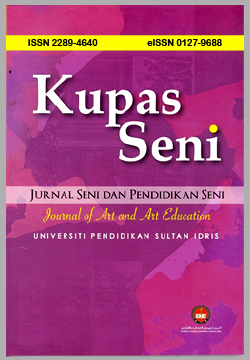Navigating the Fine Line between Plagiarism and Artistic Inspiration in Dawid Enoch's artworks
DOI:
https://doi.org/10.37134/kupasseni.vol11.3.12.2023Keywords:
plagiarism, artist inspiration, genuineAbstract
Plagiarism occurs when someone presents the work of another as their own without giving credit to the original author or obtaining permission to do so. Students, teachers, performers, artists, and designers aren't immune to this problem either. Plagiarism is a serious offence that can be traced back to factors like low self-esteem, a lack of time, and a refusal to adhere to professional norms. The fine line between legitimate artistic inspiration and unethical plagiarism is often contested and difficult to pin down in the contemporary art world. Dawid Enoch is an emerging artist whose work has sparked discussions about what constitutes ethical appropriation and what constitutes creative inspiration. The study employs semi-structured interviews with the artists in order to elicit nuanced responses on plagiarism, the artists' experiences with spotting or being accused of plagiarism, and the artists' perspectives on the moral issues raised by artistic inspiration. Dawid Enoch's "Ethereal Reverie" series exemplifies the gap that exists between plagiarism and inspiration in the visual arts. The series exemplifies how artists can draw inspiration from one another while also developing their own distinct voices and styles. The importance of being open and honest in the creative process is exemplified by Enoch's work, which is a reflection of his own dreams and emotions. The show also shines a light on the ongoing conversation happening within the art world, shedding light on the thorny issues of plagiarism and inspiration. Plagiarism devalues creativity while genuine inspiration celebrates development in the arts. Understanding the nature of art and the artist's place in society is made easier by the ongoing conversation within the art world.
Downloads
References
Ab Halim, A. H. (2020). Vivy Yusof Plagiarizing Again? Nadibangiukm. Retrieved from https://www.nadibangiukm.com/post/vivy-yusof-plagiarizing-again.
Bailey, J. (2019). 5 Historical Moments that Shaped Plagiarism. Turnitin.com; Turnitin. Retrieved from https://www.turnitin.com/blog/5-historical-moments-thatshaped-plagiarism.
Bailey, J. (2017). 5 Reasons People Plagiarize (And How to Stop Them) - Plagiarism Today. Plagiarism Today. Retrieved from https://www.plagiarismtoday.com/2017/02/15/5-reasons-people-plagiarize-and- howtostop-them/.
Cui, S., Liu, F., Guo, Y., & Wang, W. (2022) Plagiarism or reference? Exploring the detection criteria and solutions of visual design plagiarism, in Lockton, D., Lenzi, S., Hekkert, P., Oak, A., Sádaba, J., Lloyd, P. (eds.), DRS2022: Bilbao, 25 June - 3 July, Bilbao, Spain. https://doi.org/10.21606/drs.2022.776.
Hidayatullah, R., & Wendhaningsih, S. (2021). Online art class: A study on the cause and effect of plagiarism. AKSARA Jurnal Bahasa dan Sastra 2(1), 116 – 127.
Hillerman, A. L. (2023). Factors Influencing Plagiarism Amongst Undergraduate Students at an Institution of Higher Learning: Kwazulu-Natal. Proceedings of The Focus Conference (TFC 2022). https://doi.org/10.2991/978-2-38476-006-0.
Intellectual Property Law. (2017). Copyright Act 1987. mylawyer.com.my. Retrieved from https://www.mylawyer.com.my/copyr/.
López, I. (2022). Prince vs Andy Warhol: The lawsuit that could redefine appropriation in the art world. EL PAÍS English Edition.
Madeline, H. (2021) "Cheating in the Digital Age of Art," Line by Line: A Journal of Beginning Student Writing, 7(1), Article 7.
Magdalia. (2018) Artistic plagiarism– Plagiarism. Sites.psu.edu. Retrieved from https://sites.psu.edu/magdaliapassionblog/2018/04/12/artistic-plagiarism/.
Norman, M., Gondek, C., Seebacher, D., Breitinger, C., Keim, D., & Gipp, B. (2018). An Adaptive Image-based Plagiarism Detection Approach. 10.1145/3197026.3197042.
Roig, M. (2015). Avoiding plagiarism, self-plagiarism, and other questionable writing practices: A guide to ethical writing. PhD Thesis.
Tao, L. (2018). On Image: “Image” in meaning and visual rhetoric analysis. J. Bimonthly 149, 1–9.
The Official Portal of Intellectual Property Corporation of Malaysia. (2019). Copyright Basic. MyIPO. Retrieved from https://www.myipo.gov.my/en/copyright-basic/.
University of Oxford. (2022). Plagiarism. University of Oxford; University of Oxford. Retrieved from https://www.ox.ac.uk/students/academic/guidance/skills/plagiarism.
Downloads
Published
How to Cite
Issue
Section
License
Copyright (c) 2023 Nurul Shima Taharuddin, Nor Aileen Ibrahim, Yelly Andriani Barlian, Nurul Fadzila Zahari, Nur Amani Md Noordin

This work is licensed under a Creative Commons Attribution-NonCommercial-ShareAlike 4.0 International License.





